Q&A – Ask Neil: October 20, 2022
(Please read these instructions carefully.)
Before you post your question, please look at recent issues to see if someone else has already asked it. You might find your answer there.
How to submit your question…
• Click here to post your question.
• After you submit your question, a new window will pop up giving you the address to which you can e-mail a photo to accompany your question. Clear, medium-resolution photos. (Try to avoid low-res thumbnail photos, please, in case I have to zoom in to see things.)
• Please only post your question one time.
• One question per reader, please.
• Please use this only for posting questions – not for standard emails.
Note: I will answer questions you post this week in the Nov. 3 edition of e-gardens.
• I choose those of greatest general interest. For example, plant IDs seldom make the cut.
• I must have your first name or initials.
• I must have your city or county. (Texas is a very large state.)
QUESTION 1
WILL FERTILIZER MAKE ITS WAY THROUGH PINE BARK MULCH?
Question: My beds are heavily mulched. Will granular fertilizer work its way to the soil, or am I just fertilizing the pine bark? Bob G., Burleson.
Answer: I actually am going to answer two questions. The unasked one is that I like to use about 1 inch of finely ground pine bark mulch on my own beds. Any more than that and I feel like I’m putting down a barricade that will keep some of the water from rain and irrigation from reaching the soil and roots. I use a thinner layer and apply it twice as often. I prefer to do that than to double up on the thickness of the layer.
But we are where we are, so I need to answer your real question. I would apply the granules when the mulch is fairly dry, then I would quickly run a rake lightly over the mulch to “shake” the granules down in the layer. Water heavily immediately and they should be carried down to the soil. Even dry bark chunks probably won’t absorb much of the nutrition.
QUESTION 2
WILL VARIEGATED PRIVETS SURVIVE EXTREME PRUNING?
Question: I have four variegated privet trees that are 10 ft. tall and 6 ft. wide. Would they survive if I cut them back to 1-2 ft. and tried to start them over, or should I try to get rid of them? They get unsightly very fast. Shawn S., Prosper.
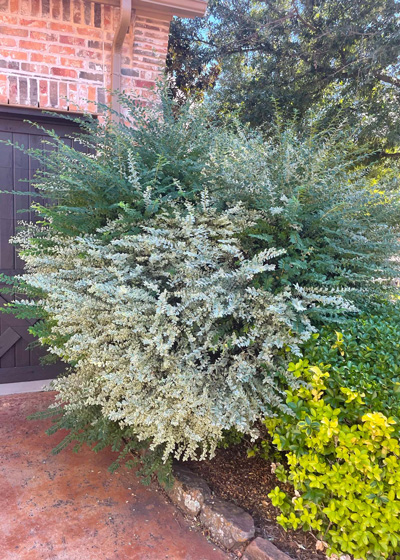
Answer: Part of the problem is that the variegation isn’t stable. You’ll see regular green privet popping up in the plants all the time, and the green portions are even more vigorous. I worry that they might produce fruit and become horrible invaders. If you try cutting them back start by removing all of the green stems entirely. Then reshape the white portions as needed to produce a good shape on each plant. You could try that one time and see how you liked the results, although you probably wouldn’t want to cut them back to 1-2 ft. That would be too drastic. Do the trimming in mid-winter.
QUESTION 3
IS THIS VARIEGATION NORMAL IN CAST IRON PLANT?
Question: My cast iron plant has developed this variegation in its leaves. I usually fertilize it with a high-nitrogen lawn food. Could I be using the wrong fertilizer? Kay L., Dallas.
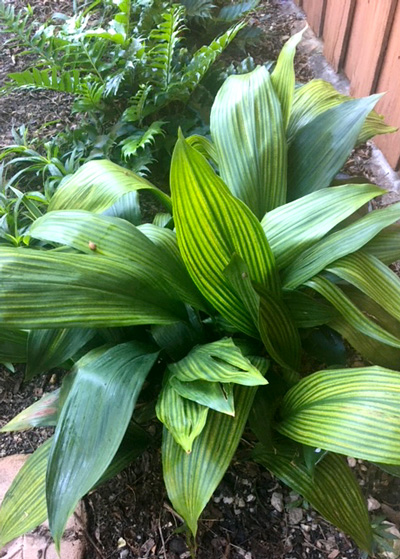
Answer: I don’t know. The fact that it’s so uniformly spread across the entire plant makes me wonder if it might be a variegated type. I’ve come to believe that almost anything is possible with aspidistras after seeing what Plant Delights Nursery has to offer in their collection. On the other hand, a couple of nutrient element deficiencies do look like this. I would suggest that you apply a high-nitrogen, water-soluble plant food that also contains a “minor element package” several times a few weeks apart next spring. The plant will thrive with it, plus it would take care of any possible nutrient shortage. Who knows! You might have something new and exciting. It’s actually quite showy.
QUESTION 4
IS OAK WILT INVOLVED HERE?
Question: I purchased two Shumard red oaks that were shipped from a Florida nursery. There were six USDA inspection notices, one specific for Texas, but for nematodes. I’m not sure if the leaves are showing oak wilt. I assume the USDA would not allow them to be shipped if so? Lanice B., Bryan.
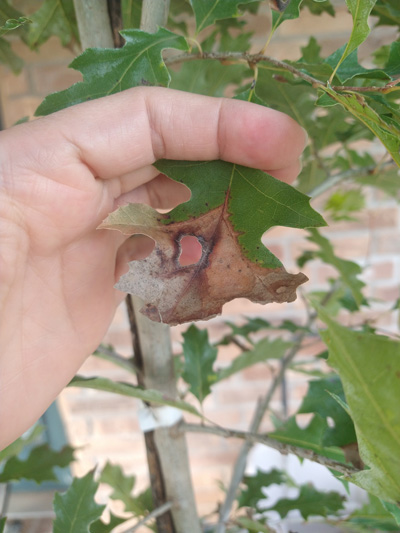
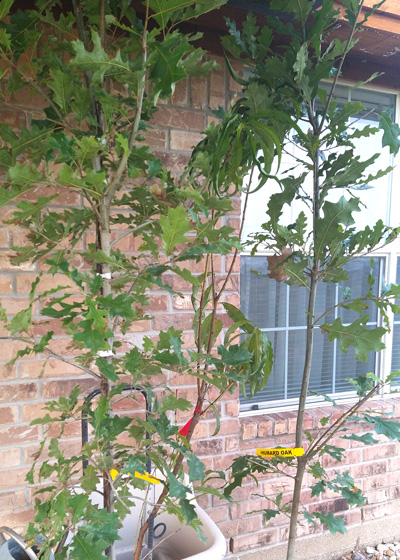
Answer: This is not oak wilt. Not even close. The trees look fine. They may have gotten just a bit too dry at some point, but there is no disease involved. You need to get them planted as soon as you can. My old theory is that nothing good happens to nursery stock while we have it sitting around our house on the driveway or patio.
QUESTION 5
WHAT IS WRONG WITH THESE ITALIAN CYPRESS?
Question: What is going on with my Italian cypresses, and what can I do for them? Eric M., Alpine.
Answer: I am concerned that this could be Seiridium canker, the disease that has rendered Leyland cypress as a virtually useless landscaping plant across Texas. I first saw it in Leylands 15 or 18 years ago, then the first time I saw it in Italian cypresses was 8 or 10 years ago, and only in the past 4 or 5 years I have seen it attacking Arizona cypresses.
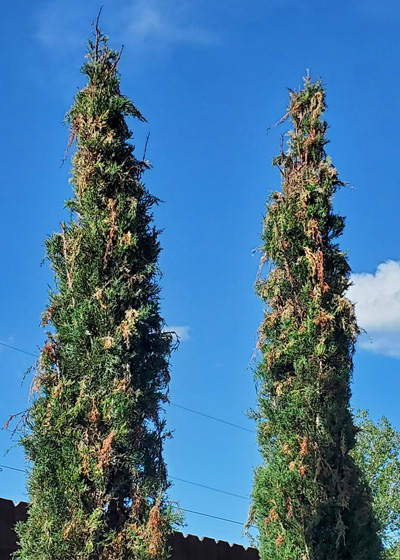

As you will read in this bulletin from Arizona’s Extension people, there is nothing we can do to eradicate it once it gets started. We can space plants farther apart at the time of planting for better air circulation, but that shouldn’t be a problem with Italian cypresses and certainly not in Alpine. I wish I had better help for you, but we’ve just had to stand by and watch this disease take out handsome specimens. I would suggest that if you want to confirm that it’s Seiridium canker, the Texas Plant Clinic at Texas A&M could culture samples of this for you to see if that’s the culprit.
QUESTION 6
WHY NO FLOWERS ON MY BLUE DAZE PLANTS?
Question: Beautiful Blue Daze plant in pot on balcony. Great leaves but no flowers all season. Why? Joan L., Frisco.
Answer: Almost always it stems back to not enough sunlight. Blue Daze (Evolvulus) grows well in partial shade, but it blooms best where it gets a good bit of sunlight – shade only from the hottest afternoon sun. It’s also possible that the plant received excessive nitrogen in its fertilizer, but that’s usually not the prime cause.
QUESTION 7
HOW CAN SOIL IN PERENNIAL GARDEN BE AMENDED WITHOUT DISTURBING THE PLANTS?
Question: The growth and flower output of the perennials in our sunny backyard beds have greatly declined over the past several years. What’s the best way to amend the soil without disturbing the roots of established perennials? Robyn O., Plano.
Answer: I don’t think that’s possible. Perennials need to be dug and divided every few years or they will become overcrowded all on their own. The wear-down of the planting soil is a separate problem altogether. Fall is the ideal time to separate spring-flowering types, so you might want to get that done as quickly as possible now. Time is slipping away. While you have them up and out of the bed, use a mini-tiller to work several inches of new organic matter into the soil and you and your plants will be as good as new! You’ll also have plants to share with friends.
QUESTION 8
WHY NO BLOOMS ON MORNING GLORIES?
Question: This is the second year I’ve tried to grow morning glories, but again, no blooms. They get full sun. Maybe too much water? Steve R., Arlington.
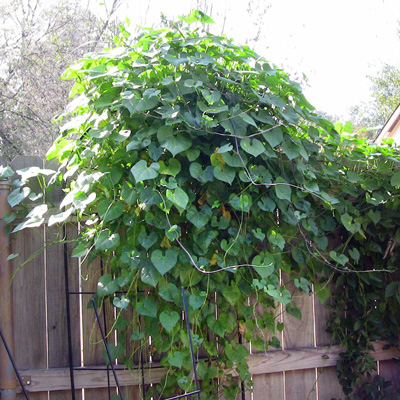
Answer: They do, indeed, look luxuriant. Morning glories are photoperiodic, meaning that they measure the length of the nights to determine when it’s time to flower. They wait until fall to produce their blooms. Out of curiosity, there is no street or security light near this plant, is there? If you’re willing to try them just one more time, I would cut back a bit on the water from mid-summer on and avoid high-nitrogen lawn fertilizer around them from that point on, too. You’re doing so well growing the plants that I want to encourage you to keep trying.
QUESTION 9
HOW CAN I DEAL WITH VOLES?
Question: I have been told I have voles in my St. Augustine lawn. They appear as spider-web-like cracking in the now bare dirt. This is not from lack of water thanks to my sprinkler system. Ideas? James L., Dallas.
Answer: I honestly have no idea. I’ve lived in the Dallas area where you are for 53 years, and I have never seen nor heard of a vole problem in St. Augustine lawns. Here is a fact sheet that Texas Tech has online related to the most common form of voles in Texas, although they describe it as “not common.”
And here is a link to a comprehensive discussion of what I know to be the most common St. Augustine problems that I posted onto my website.
QUESTION 10
IS IT TOO LATE TO TREAT FOR GRUB WORMS?
Question: Is it too late to treat for grub worms? Faylene H., Ben Wheeler.
Answer: You will still get some benefit if you treat soon. Apply granules labeled for their control followed by a heavy watering, but do so right away, and only if you have found 5 or more grubs per square foot of soil. The grubs will soon finish their active feeding. At that time they will move down in the soil and prepare to pupate into the adult beetles that fly, mate and lay eggs that start the entire cycle all over again.
